Bayonets-daggers versus bayonets on bushings
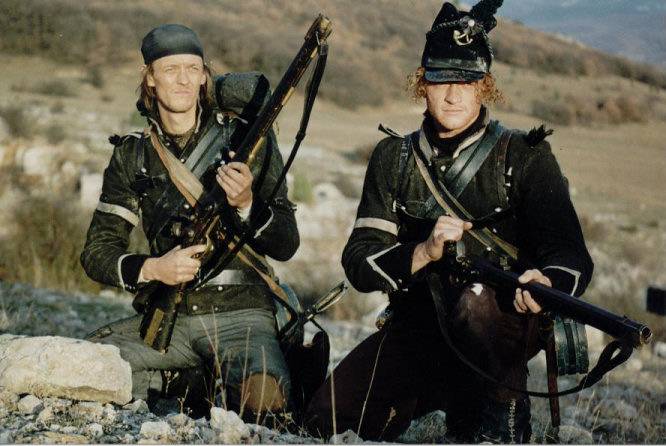
"Sharpshooters" with a horn on a cap. This is how they were, this is how they are presented in the series about the king's shooter Sharpe.
Do not they dare, commanders
Strangers tear their uniforms
About Russian bayonets? "
(Borodino. M.Yu. Lermontov)
History weapons. At the beginning of the XNUMXth century, such a type of trade as trapping, the extraction of animals, most often beaver skins, with the help of traps, spread in North America. Trappers described Fenimore Cooper very well in his Leather Stocking series, although he did not talk about some of the nuances of their profession.
And the thing was that, leaving for a long time from residential areas to where the unafraid animals lived, the trapper simply physically could not carry with him, among other things, a gun of a sufficiently large (or rather, let's say: traditionally large) caliber, characteristic for flintlocks of that time. It took too many charges and too much lead.
Trapper weapons
And the gunsmiths did the seemingly impossible.
In 1735, the Kentucky rifle (caliber 10 and 12,7 mm) was developed with a thin buttstock and a length of 1,37–1,52 m. The barrel was also rifled, which made it possible to achieve excellent accuracy. It has been proven that a shooter from "Kentucky" could hit the head of the enemy from a distance of 200 meters, and into a motionless figure - from 300, or even from 400 meters.
In the shooting competitions, it was necessary to hit a target with a diameter of 12 centimeters from a distance of 18 to 230 meters, and there were such snipers who managed to do this at the maximum distance. So the fatal accuracy of the famous Nathaniel Bumpo is by no means an invention of Fenimore Cooper, not his "romantic fantasy." There were arrows like him.

Trapper shooters: 1. "Morgan Shooter" with a "Kentucky" gun with a pencil case in the stock. On his right hand hangs a kind of loading accelerator: a plate with cut holes, into which bullets with wads are pressed. To load a bullet into the barrel, the plate was pressed against the muzzle and pressed into it together with the wad. Thanks to this, the loading process is at least three shots, and accelerated. 2. Some pathfinders copied the Indians ... 3. Pennsylvanian shooter from the "Pennsylvania Thompson Riflemen" with the "Kentucky" type "Pennsylvanian" gun 1770 5, 6, 7, 8. Flags under which the rebel colonists fought against the British.
Illustration by Liliana and Fred Funkenov from the book “Encyclopedia of Weapons and Military Suit. Wars on the American continent of the 2003th – 13th centuries. M .: AST / Astrel, XNUMX S. XNUMX
True, the Kentucky rifle also had its drawbacks.
And the biggest one is slow loading. Before putting a bullet into the barrel, it was necessary to place a paper wad (or a piece of oiled suede) on its muzzle, put a bullet on it and, together with the wad, push it into the barrel onto a charge of gunpowder.
By this time, rifled guns already existed. But for some reason it was believed that the less the bullet was hammered into the barrel, the better, the more accurately it would fly. Therefore, the bullets were hammered into the barrels with special wooden mallets, which is why they were deformed and ... due to poor aerodynamics, they did not fly as accurately as they could.
True, even with such (deformed) bullets, accuracy was still higher than that of those fired from ordinary smooth-bore muskets. Well, and already "Kentucky" was even less competitive. After all, the bullet did not hammer into it and therefore did not deform.
Without bayonet
But ... here we must remember about its second drawback.
The absence of a bayonet. Therefore, when the war of independence began, and the trappers were drafted into the ranks of the Continental Army, it turned out that they could not fight on equal terms with the British soldiers.
Yes, shooting at their dense mass from a distance, they perfectly hit
(that was the name of the British soldiers for their red uniforms) and didzens of them were wounded or killed.
But as soon as they rushed at the shooters with bayonets, they were forced to flee and with maximum speed, because they simply had nothing to repulse such an attack with.
This is why, by the way, George Washington put so much effort into building a disciplined regular army capable of fighting in a European manner.
And when he succeeded, running around the battlefields back and forth like hares, his soldiers immediately stopped. And the trappers-shooters immediately found a tactical niche corresponding to their capabilities.
Now they met with fire from afar the advancing British infantry or cavalry, and when the "red uniforms" came very close, they left behind the line of line infantry, which acted, like the British, with bayonets.
They also used them as scouts and snipers. So the traditions of sniping in America are very old and are by no means connected only with the history of the civil war of 1861-1865.
Well, and the damage inflicted by these shooters of the British army is best illustrated by the following statement from the "Middlelexes Journal" of December 31, 1776:
As for the British, they, fighting in America, were armed with their popular musket "Brown Bess" or "Brown-haired Bessie".
Its main advantages were, firstly, a large caliber, equal to 19 mm, and secondly, a perfect mechanism that allowed trained infantry to fire volleys at a speed of 5-6 rounds per minute.
And although hitting the target with this gun was (by contrast) more difficult than with a Kentucky rifle, it should be remembered that in practice these rates of fire meant that 2000 soldiers could fire 10000 bullets at the enemy per minute. At a distance of 70 meters, this meant the total destruction of all living things.
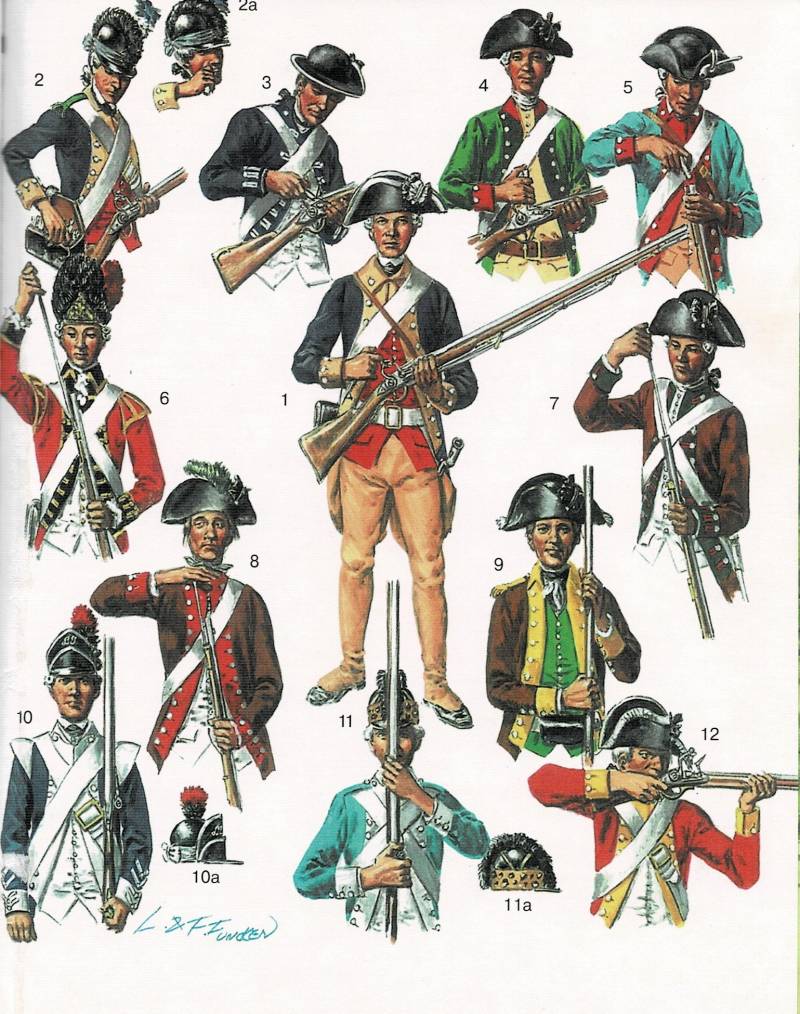
The process of loading an army musket of the era of the American Revolutionary War: 1. A soldier of the "Commander-in-Chief's Guard", also called the Life Guards of George Washington (1777-1783), begins loading: the trigger is half raised and put on safety, the cover of the powder shelf (flint) is raised and opens the shelf. 2. Soldier of the light infantry of the Guard of George Washington (1777-1783). The soldier executes the command "bite the cartridge", that is, "bites" with his teeth, breaks the paper sleeve. 3. A soldier of the 2nd Virginia Regiment (1775-1778) puts gunpowder on a shelf. 4. A soldier of the Green Mountain Boys battalion, Colonel Warner (1775), lowers the lid on the shelf and closes the bitten cartridge with his thumb. 5. A soldier of the 2nd New Hampshire Regiment (1776-1778) pours gunpowder into the barrel, and then puts a bullet and a wad. 6. Soldier of the Foot Guards of Connecticut (1775). He is dressed in a red uniform, but it was abandoned so as not to confuse “friends” with the British. He takes out the cleaning rod. 7. Soldier of the 1st Pennsylvania Battalion (1777). Tightly hammers the wad and bullet into the barrel with a ramrod. 8. A soldier of the additional regiment Lee (1777) (such regiments recruited volunteers from different places, and not from one state) removes the ramrod in place. 9. A soldier of the additional regiment of Sherbourne (1779) shifts the gun to his left hand. 10. A soldier of the light continental infantry (1783) takes a gun on his shoulder. 11. A soldier of light infantry Lafayette (1781) carries out the order to open fire: he takes a musket with both hands. 12. A soldier of the additional Webb regiment (1777-1781) puts his gun to his shoulder, takes aim and fires.
Illustration by Liliana and Fred Funkenov from the book “Encyclopedia of Weapons and Military Suit. Wars on the American continent of the 2003th – 17th centuries. M .: AST / Astrel, XNUMX S. XNUMX
The soldier was not even taught to aim especially.
The commanders had to be able to determine the distance by eye and command:
And the soldier had to send his "Bessie" only to this level. And, most importantly, in the direction of the enemy, that is, "shoot at the crowd," as they said then.
And it turned out that in the battle the one who fired more often won.
At the same time, with a caliber of 19-mm bullets for "Bessie" had a caliber of 18 and even 17,8 mm. That is, such a bullet did not even have to be driven into the barrel with a ramrod, but it was enough just to throw it into the barrel and then hit the ground with the butt of the gun in order to nail it tightly to the powder.
And at a distance of 120 meters, a shot with such a bullet gave quite satisfactory accuracy. By the way, until 1736 the ramrod for this gun was made of wood, made of walnut, and since 1750, without exception, all ramrods have become metal.
In addition, the Kentucky rifle was considered the best rifled gun until 1840, and the Brown Bess (produced, it is believed, in the amount of 8-10 million copies) was used even after 1850 and after the widespread transition to capsule systems. Well, and, of course, the "Bessie" had a long bayonet, which made it possible to use it in hand-to-hand combat and to successfully repel cavalry attacks, which was demonstrated by the Battle of Waterloo.
However, the Kentucky rifle also had something to be proud of.
So, during a skirmish at King's Mountain in 1780, loyalist militiamen of Major Patrick Fergusson (armed with a rapid-fire musket of his own design) and Continentalist riflemen met by chance. The oncoming battle then lasted less than an hour. And during this time 338 loyalists were killed or wounded, and many were shot in the forehead between the eyes.
Major Fergusson was undoubtedly the # 1 target, so it shouldn't come as a surprise to be hit with eight bullets. The case then simply did not come to a bayonet attack, such was the deadly accuracy of the "Kentucky rifle".
Jaeger teams
It must be said that detachments of especially well-aimed shooters - rangers, recruited from hunters, foresters and the same rangers (since at that time it was a responsible and popular profession and there were quite a few of them), were used even during the Thirty Years War.
Subsequently, whole units of "well-aimed shooters" appeared, in particular in Russia a battalion of rangers was created in 1761, and since 1763 the rangers were officially registered in the army as light infantry units.
Then jaeger rifle teams of 65 people with one officer began to create with all the infantry regiments of the Russian army. And later, they began to create regiments from them and bring them into divisions. True, not everyone there received rifled guns, but in any case, their number in the armies of Europe began to grow.
And here a certain problem arose related to the bayonet ...
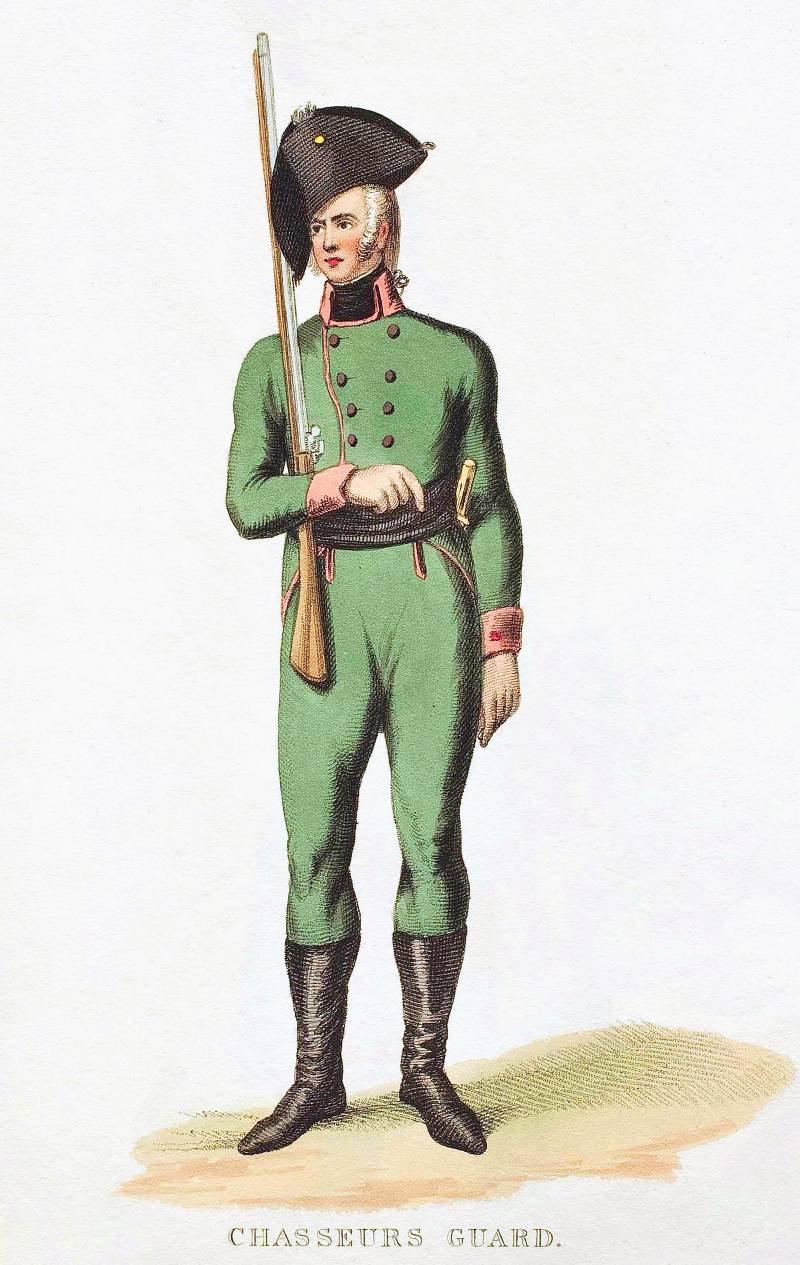
The shooter of the Life Guards of the Jaeger Battalion. The uniform of the Russian army from the collection of drawings by Count Kinneard 1807
The Jaeger Battalion was formed on November 9, 1796
On May 10, 1806, the battalion was reorganized into the Life Guards Jäger Regiment, consisting of two battalions, which in turn consisted of four companies.
And then a third battalion was added to them, also of four companies.
Chief of the regiment in 1806-1812. was General Prince P.I. Bagration, and the commander in 1806-1809. was Colonel Count Emmanuel Frantsevich de Saint-Prix.
In 1802, privates wore round hats, trimmed on top with an orange trim, instead of which the non-commissioned officers had a gold braid. The tassels on them were orange with a green center. The cuffs, like edging, are orange. The color of the uniform is green, as is the color of the "winter" pants, while in the summer they wore white.
In 1804, officers received two-cornered hats with buttonholes made of narrow gold lace, decorated with a tall green sultan, and lower ranks received cloth hats.
In 1805-1807. the battalion fought in the battle of Austerlitz (20.11.1805), 24.05.1807 - in the battle of Lomitten, and on 2.06.1807 took part in the battle of Friedland.
In the same England, or rather in the British troops in the American colonies, a unit similar to the gamekeepers appeared in 1756, and for them, together with the traditional "Brown Bess", German fittings were purchased, which fired much more accurately.
A second similar unit appeared in 1800 under the name: "Experimental Rifle Corps", armed with Baker fittings. It is interesting that the transmission of commands in it took place not with the help of a drum (as in linear regiments), but with the sounds of a horn. The color of the uniforms was also changed: from the traditional red for the British, it was changed to green.
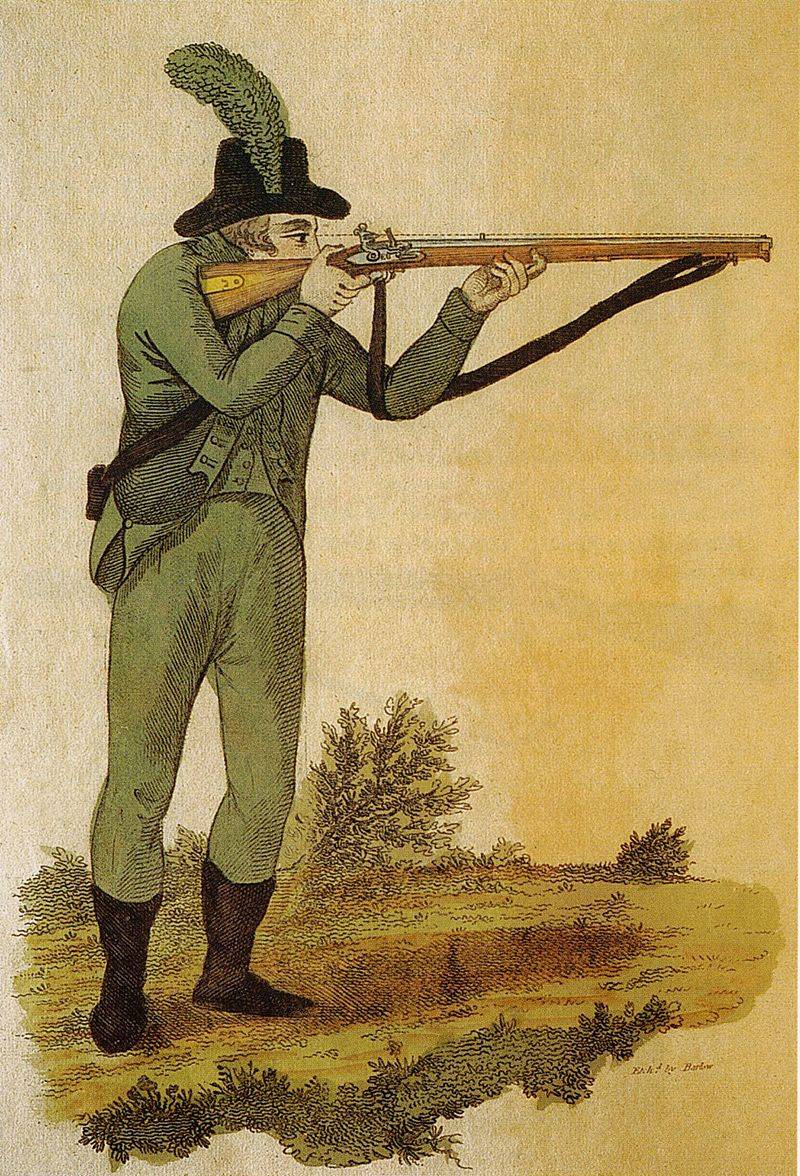
A British shooter from the Green Jacket Regiment fires a Baker carbine using a belt. Illustration from Ezekiel Biker (1758–1836) 22 Years of Shooting Practice and a Review of Rifled Weapons, 1st Edition 1803
The fact is that, if the Kentucky rifle, although it did not have a bayonet, was at least long, the rangers' rifled guns were short, since the bullets were driven into them.
And the gamekeepers themselves recruited people 5,5 feet in height to make it easier for them to "apply to the terrain." And since now the huntsmen had to "go with bayonets", it turned out that their weapons in this type of battle began to lose to the weapons of the line infantry. We tried to make very long bayonets for them, but it turned out that they were inconvenient to use.
Dirk

Baker's rifle, model 1803, barrel length 495 mm, total length 892 mm, weight 4,08 kg. Caliber .625 (15,9mm). Royal Arsenal. Leeds
A way out was found in the use of blade bayonets-cleavers (or, as they were still called then - bayonets-daggers) of considerable length, with which the rangers were armed. That is, it was realized that for those units for which bayonet fighting is not the main one, it is more profitable to have a bayonet with a bladed one, so it can be used for other purposes.
A purely piercing bayonet has become an attribute of the line infantry, while a cleaver (suitable for all other needs) has become an addition to the infantryman's main armament.
Such bayonets, and even with a guard, in 1788-1801. had, for example, Danish infantrymen.
Long bladed boarding bayonet received by the British Royal Marines fleet in 1859 to the Enfield rifle.
And of course, it is absolutely impossible to forget the French bayonet-epee of 1874 for the Gra rifle. He had a guard with a hook for grabbing the enemy's blade and a ring to put it on the barrel. The handle is made of brass with wooden plates. The blade is very long with a T-shaped profile that gives it great strength.
A lot of these bayonets were fired. And it happened that even those soldiers who could not use them exactly as bayonets received them instead of cleavers.
The Spanish halberd bayonet of 1857 was very original. It had a cast brass handle, a crosshair with a curved spike located on it and a hatchet in the shape of an inverse crescent. And, most interestingly, a blade with a wavy blade.

The handle is almost the same as that of the Gra rifle, but the blade is completely different. Before us is a bayonet for the Italian rifle Vetterli 1869/1871
That is, a new trend has emerged in the development of the bayonet.
But in more detail about how the replacement of stabbing bayonets with bladed bayonets took place, will be discussed next time.
To be continued ...
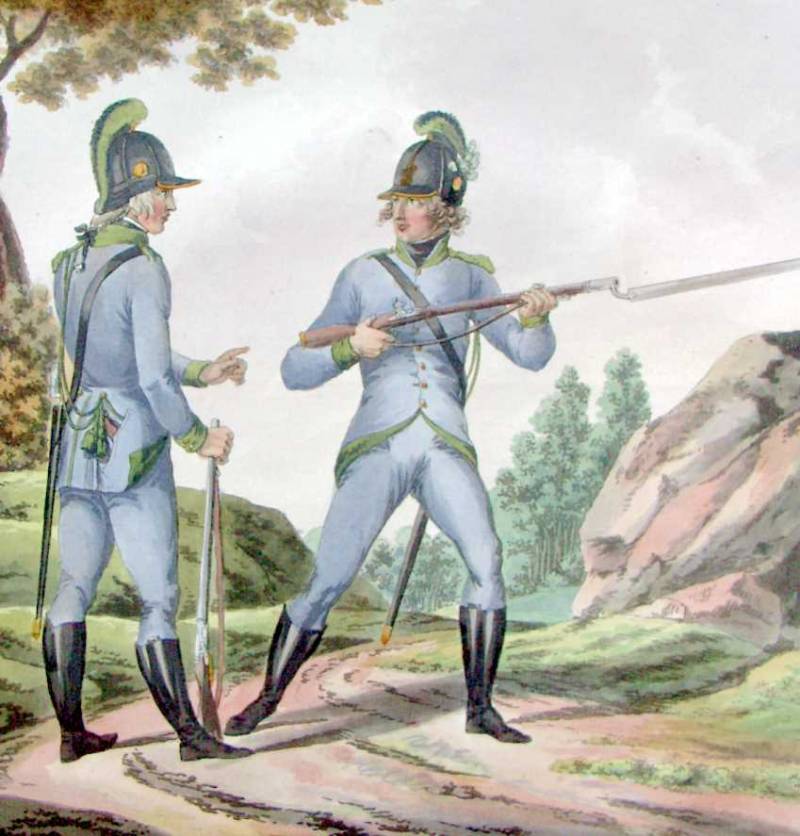

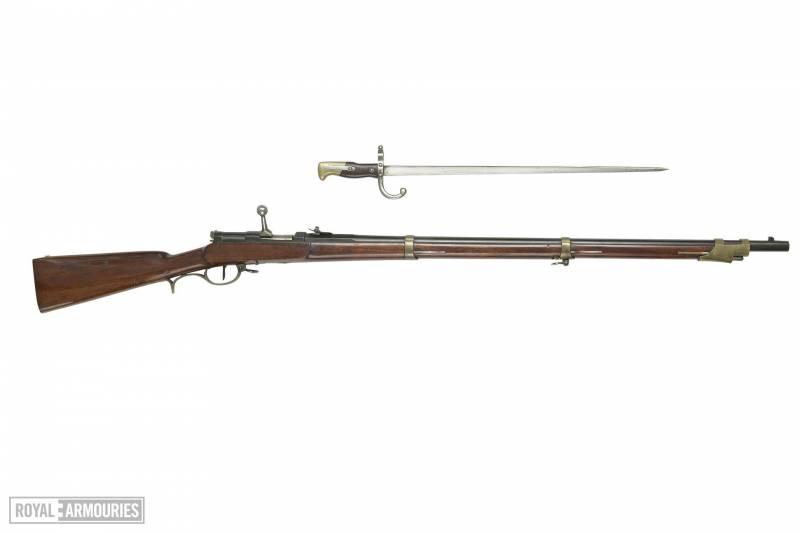
Information